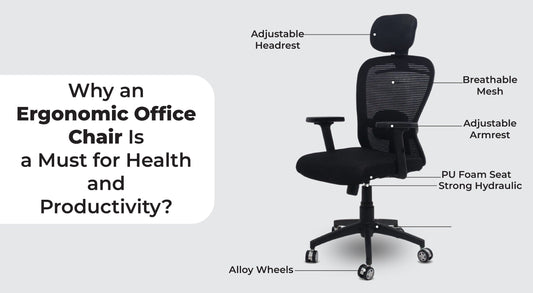
Why Student Needs an Ergonomic Study Chair for Better Focus and Health
My CubiclesIn today’s fast-paced academic environment, students are spending more time seated than ever before—whether it's for online classes, assignments, or self-study. But have you ever stopped to consider the impact of sitting for hours in an unsupportive chair? From back pain to poor concentration, the effects can be far-reaching. That’s why investing in an ergonomic study chair for students isn't just a luxury—it's a necessity for their physical health and academic performance.
Understanding the Importance of Posture in Student Life
Good posture isn’t just about sitting up straight. It plays a crucial role in maintaining energy levels, reducing fatigue, and improving concentration. For students, posture is often neglected—especially when studying on beds, dining chairs, or cheap plastic seats.
Poor seating posture can lead to:
- Muscle fatigue and tension in the neck and lower back.
- Slouching that reduces oxygen flow and focus.
- Discomfort that leads to fidgeting and distraction.
Over time, these habits can develop into chronic issues that may affect students throughout their academic and professional lives.
What is an Ergonomic Study Chair?
An ergonomic chair is specifically designed to support the natural curve of the spine and encourage a healthy sitting posture. For students, this means:
- A backrest that supports the lumbar spine
- Adjustable seat height to align with the desk
- Armrests that reduce strain on shoulders and wrists
- A cushioned seat for extended sitting periods
Compared to ordinary study chairs, ergonomic chairs for students offer enhanced comfort, support, and long-term health benefits—especially during exams or long learning sessions.
Benefits of Using an Ergonomic Study Chair for Students
An ergonomic study chair is more than just a comfort upgrade. Here's how it can make a real difference in a student’s daily life:
Improved Focus and Productivity
When discomfort is out of the equation, students can focus better and longer, leading to improved comprehension and output.
Prevents Back and Neck Pain
Proper lumbar support helps reduce pressure on the lower back and neck, minimizing pain even after hours of study.
Encourages Correct Posture
The design of an ergonomic student chair promotes alignment of the spine, shoulders, and hips, setting the foundation for lifelong good posture.
Enhances Academic Environment
A comfortable, well-designed chair improves the overall study setup, making it more inviting and conducive to learning.
Signs Your Current Study Chair is Hurting Your Health
Not sure if your current chair is doing more harm than good? Watch out for these signs:
- Frequent complaints of back or neck aches
- Restlessness or inability to sit still while studying
- Slouched or leaned-over posture
- Needing to get up frequently to "shake off" discomfort
If these symptoms sound familiar, it may be time to rethink your seating choice.
How to Choose the Best Study Chair for Students
With so many options available, choosing the right chair can feel overwhelming. Here’s what to keep in mind:
Adjustable Seat Height
Ensure your child’s feet touch the ground while the knees form a 90-degree angle.
Lumbar Support
A good chair offers lower back support that maintains the natural curve of the spine.
Breathable Material
Mesh or fabric seats allow airflow and reduce sweating during long study sessions.
Swivel and Mobility
A revolving study chair with smooth movement adds flexibility to the learning experience.
Size Appropriateness
For younger students, opt for compact models. Teens and college students may benefit from high-back ergonomic study chairs.
Creating a Productive Study Setup with the Right Desk and Chair Combo
The chair is only half of the equation. For a truly ergonomic setup:
- Match chair height to desk height so elbows rest comfortably
- Use a footrest if feet don’t reach the ground
- Position screens at eye level to prevent neck strain
- Keep frequently used items within arm’s reach to reduce twisting
- Adding a quality desk lamp, some green plants, and good lighting can turn a study corner into a productive haven.
Expert Tips to Encourage Better Sitting Habits Among Students
Buying the right chair is just the start. Encourage these healthy habits:
- Take a 5-minute break every 30-40 minutes.
- Teach students to sit with their back touching the chair and feet flat.
- Discourage slouching over devices or textbooks.
- Use timers or apps that remind them to stretch or walk.
- Set up a dedicated study space, even in smaller homes
Parents and teachers can model and encourage these behaviors to build long-lasting healthy habits.
Common Myths About Study Chairs and Student Seating
“Any chair is fine for short study sessions.”
Even brief periods of bad posture add up. Proper support matters, no matter the duration.
“Ergonomic chairs are too expensive.”
Today, many affordable ergonomic options exist for all budgets—and they’re far cheaper than medical bills later.
“Kids don’t need ergonomic chairs.”
In fact, growing spines benefit the most from correct support. Early habits shape long-term health.
Final Thoughts: Building Better Study Habits Starts with Better Seating
Students today face more academic pressure than ever. In such a demanding environment, something as simple as a comfortable, supportive study chair can make all the difference. Not only does it improve focus and academic performance, but it also promotes physical wellness that lasts a lifetime.
Investing in an ergonomic study chair isn’t about luxury—it’s about providing the right foundation for a child’s education, comfort, and future health.



